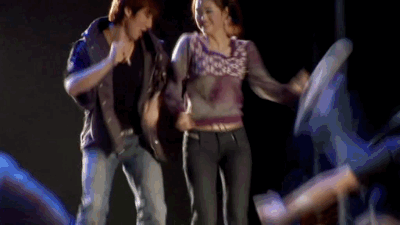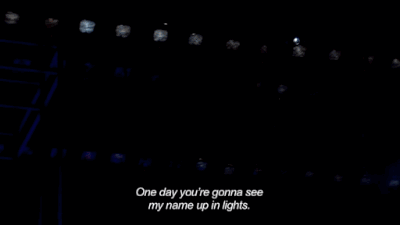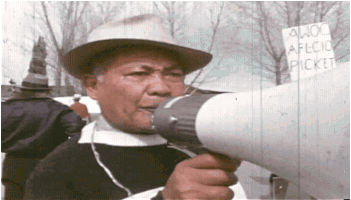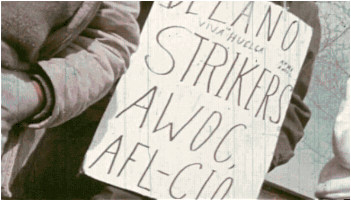Film. Music. Food. Join us at CAAMFest from March 13 – 23, 2014!
Don't wanna be here? Send us removal request.
Text
John Cho on "Selfie" and being an Asian American actor
"Just from a creative standpoint there are just entire genres that I’m locked out of, being Asian, because of historical reality. You know, like the cowboy picture (laughs). Basically you’re doing immigrants, smaller immigrant roles. And if you’re doing bigger roles, you’re doing modern tales. That is to say, contemporary stories. And you can do futuristic stories. So I guess I’ve done those.
What I’m locked out of is American history. There just aren’t roles written for Asians in stories that revolve around American history. So you’re dealing with that handicap off the bat."
Read more of our interview with John Cho at CAAMedia.org.

Caption: John Cho and Karen Gillan star in Selfie. Social Media superstar Eliza Dooley (Karen Gillan) has 263,000 followers who hang on to her every post, tweet and selfie. But after a workplace mishap goes viral, she quickly realizes that being “instafamous” isn’t all it’s cracked up to be and being friended is not the same as having actual friends. ©Eric McCandless/ABC.
0 notes
Photo


The late civil rights activist, Japanese American Yuri Kochiyama, is the subject of Rea Tajiri’s Yuri Kochiyama: Passion for Justice (1993). The documentary screens Thursday, September 4 at 7 p.m. at the Japanese American Museum of San Jose. The screening is free. Please RSVP at [email protected].
On people of color uniting:
“My priority would be to fight against polarization. Because this whole society is so polarized. I think there are so many issues that all people of color should come together on, and there are forces in this country who want this polarziation to take place.”
To read more of Yuri Kochiyama's quotes, information about an upcoming New York memorial, and musician/educator Taiyo Na's essay about Yuri Kochiyama and Tupac Shakur, go here.
"Because if a Japanese American woman such as Yuri and Malcolm X were a hard pairing for people to imagine, then undoubtedly in public imagination Yuri and THUG LIFE are too; and what people don’t understand about Yuri reveals exactly how much we don’t understand about social movements." - from "Yuri, Tupac, and a Harlem House" by Taiyo Na
1 note
·
View note
Photo


Time flies, ya’ll. Remember Spencer Nakasako’s documentary Kelly Loves Tony, a film about two Southeast Asian teenagers from Oakland? Momo Chang from CAAM catches up with Kelly Saeteurn. - AW
60 notes
·
View notes
Photo

Asians have been American for generations, and we’ve got the home movies to prove it.
Check out the Center for Asian American Media’s new project: collecting and preserving Asian American home movies.
127 notes
·
View notes
Text
CAAM Contest: Win a pair of tickets to "Alec Mapa: Baby Daddy"!
Frameline Festival is coming to San Francisco from June 19-29! To gear up for the world's largest LGBT film festival, we're excited to give CAAMers an opportunity to watch an exclusive look at Alec Mapa: Baby Daddy! The film captures the award-winning, sold-out comedy performance from Alec Mapa (Ugly Betty, Desperate Housewives), while also showing a touching profile of his life and story.
Win a pair of free tickets to Alec Mapa: Baby Daddy by entering our contest! The rules are simple. To enter, you must "like" the CAAMedia Facebook page and post a response to our contest question. The contest will end on June 16, 10 am. Winners will be announced June 17. Good luck!

Contest Guidelines: 1. Like our CAAMedia Facebook page. 2. Post a response to our contest question. 3. Stay tuned! Winners will be announced Tuesday, June 17 at 10 am. Contest Prize: A pair of tickets Alec Mapa: Baby Daddy (2013, 78 min). Sunday, June 22, 6:30 pm. Victoria Theater (2961 16th St)., San Francisco.
Photo source.
#contest#san francisco#frameline festival#frameline#framline38#caam#center for asian american media#alec mapa#comedy#stand-up
1 note
·
View note
Quote
Have you ever had to deal with any direct or indirect racism in the industry? When I was working at Channel One, Rolling Stone magazine had this “hot” issue. They named like “hot hamburger,” “hot actor,” “hot designer” and they had a category called “hot reporter.” And one year, they named me as their “hot reporter.” I was like 19 or 20 years old. While I was at Channel One, someone cut that photo of me out of the magazine and drew slanted eyes on it and put it in my mailbox. And it was one of the most horrifying experiences that I’ve ever had because I walked out of that mail room and everyone looked guilty to me. And it was so hurtful because up until then, these people were my family. I was traveling to war zones with some of these people, and spending more time in my office than I would spend anywhere else.
from CAAM's Interview with Lisa Ling
-Momo Chang
1 note
·
View note
Text
Sailor Moon - A Feminist Revival

Over the next few months, Hulu Plus will be offering free, digitally re-mastered episodes of Sailor Moon. This is the first time Sailor Moon will have a complete airing for a U.S. audience since its initial adaption on American television in the ’90s. It was originally produced for an English-speaking audience, airing on Fox Kids, YTV, TV2, and Cartoon Network. The show helped launch anime as a global phenomenon, particularly for a female audience. The difference now, however, is that these are fully uncensored episodes (more on this later), including Season 5: Sailor Starlights, previously unreleased in North America. For loyal fans and new viewers alike, the internet has been buzzing with the chance to watch Sailor Moon’s lunar romances and intergalactic adventures again.
Over the years, Sailor Moon has launched a contentious conversation on race, gender and sexuality. Usagi’s (the main character) shortcomings and courage help make Sailor Moon an nuanced conversation around emotional and physical strength, as well as feminism.
Sailor Uranus clarifies in one episode that she is a woman. “I don’t recall ever saying that I was a guy.”
However, Sailor Moon is more complex than it seems at first glance. The plot is seemingly simple: lovable, clumsy daydreamer Usagi (“rabbit”) is mediocre in so many ways. She’s lousy at her passing her exams, usually running late, and always eating too many sweets. Her friends and family call her sensitive, a crybaby. However, with some guidance from her cat Luna and the support of her friends the Sailor Scouts, she takes on her destiny and grows in her spirit to defend her world against the energy-leaching NegaVerse.
“Why does Sailor Moon’s transformation get so much airtime?” My college room mate would ask me, a new fan of Sailor Mars. “She’s not even a planet.”
“You can’t question the lunar ways of Queen Serenity,” was my only response.
A mainstream feminist perspective on Sailor Moon’s girl-power leanings would focus on how the show’s creators showcased independent, feminine characters engaged in traditionally masculine combat. Typically, in superhero narratives, male figures reach hero status through physical aggression and dominance. Mainstream feminist thought also glorifies these same models of strength—when feminine characters are depicted with more masculine qualities, they’re seen as strong and even more feminist.
However, the Sailor Scouts also complicate feminism by showing an alternative model of strength. Their strength comes from their softness, from a sense of heart and friendship. Usagi, timid and scattered in her normal life, uses her sense of love to transform into a courageous champion for underdogs and the under-loved alike. The Sailor Scouts, led by Usagi, bring a lighthearted, fun, counter-narrative to strength and courage.
The world of the Sailor Scouts is an emotion-based cosmos. Usagi’s personhood is emotive and sensitive; she experiences self-doubt, rejection, empathy, grief, and fear concurrently with playfulness, joy, compassion, and love. As powerful as she is, Usagi challenges the traditional notion that emotions are inferior and weak.
Sailor Jupiter promotes peace—and pastries.
All the Sailor Scouts are incredibly feminine, but also vastly different from one another. Some are tougher, some are more drawn to school, some are romantics. At the risk of sounding cheesy, at the end of the episodes, what bonds them when they face the NegaVerse is their sense of friendship and loyalty to one another. These strong female friendships show a new solidarity between young girls. They often contest one another, argue, and live vastly different realities from one another, but since love and relationships are central to how the Sailor Scouts orient their ethics, their friendships deepen over time.
Of course, there are nuances to this conversation. There are opinions that that the Sailor Scouts are hypersexualized—as they transform into their powers, their accessories become magical, their skirts are shortened, their makeup flashier. Other fans respond to this argument by supporting the feminine adornment of the Sailor Scouts and the attention paid to feminine expression. From a critical race perspective, the show is also striking. Usagi’s character, the main leader of the Sailor Scouts is blonde-haired, blue-eyed, light-skinned. The rest of the Sailor Scouts are slightly more racially ambiguous, but are primarily light-skinned. As Usagi and her friends defend the universe, there are multiple criticisms that the program centers and promotes white standards of beauty, despite its diverse audience.
There is no singular, perfect feminist story. Still, the story of Usagi and her friends bring out a fascinating, sensitive dialogue about models of strength, and the different types of courage characters can embody. Catch the first episode: Crybaby: Usagi’s Beautiful Transformation, and other episodes starting this week. Let us know your thoughts!
- Hardeep Jandu
#sailor moon#hulu#center for asian american media#CAAM#usagi#queerness#gender#sexuality#sailor senshi#sailor scouts#fun#fierce
14 notes
·
View notes
Photo


This year's Directions in Sound events are a true feast for the ears. Our Here Comes Treble showcase on Saturday, March 22 celebrates achievements by leading female performers, including local favorites journalist-turned-emcee Rocky Rivera, and singer-songwriter Cynthia Lin. Also featuring sets by DJ Umami, DJ ThatGirl, DJ Roza and DJ Chauee. Don’t miss this must-see event!
Get your dance on here: http://caamfest.com/2014/events/directions-in-sound-here-comes-treble/
#CAAMFest#Center for Asian American Media#SFIAAFF#Film Festival#Directions in Sound#Cynthia Lin#Rocky Rivera#DJ Umami#DJ ThatGirl#DJ Roza#DJ Chauee#Music
15 notes
·
View notes
Video
We can't wait!
youtube
These guys are rad! World premiere of nationalfilmsociety's “Awesome Asian Bad Guys” at CAAMFest March 20th and 21st in San Francisco!
Get your tix: http://caamfest.com/2014/films/awesome-asian-bad-guys/
31 notes
·
View notes
Photo

Look at what a pretty group we have working in the festival.
6 notes
·
View notes
Photo



This year, CAAMFest is bringing back Directions in Sound for two nights!
Hosted by Kero One, our Korean Showcase on Thursday, March 20 will feature talent coming straight to us from the SXSW Music Festival, including the synth-pop '80s dance beats of Glen Check, the groovy sounds of Rock 'N' Roll Radio, and the infectious hybrid electronic pop of Love X Stereo. Also adding to the musical mix is "avant-indie" group SmackSoft and funky disco house trio, Idiotape.
For more information: http://caamfest.com/2014/events/directions-in-sound-korean-showcase/
#CAAMFest#Center for Asian American Media#SFIAAFF#SXSW#Film Festival#Glen Check#Idiotape#Kero One#Love X Stereo#Rock N Roll Radio#SmackSoft#Directions in Sound#Korean#Music#Dance#Disco#Electronic#House#Indie#Pop#Rock#KPop#KRock
0 notes
Photo








American Broadway meets China’s larger-than-life theatrical dream in The Road to Fame, as young students from China’s highly-esteemed Central Academy of Drama are given their senior year finals: to be cast and to perform in Fame. Director Hao Wu addresses the universal persistent and uncomfortable questions of youth, while also addressing the realities of the first generation affected by China’s one-child policy.
#The Road to Fame#Hao Wu#CAAM#CAAMFest 2014#Center for Asian American Media#Asian American#Film Festival#San Francisco#SFIAAFF#Bay Area#Berkeley#Oakland#Documentary#Film#Broadway#China#Drama#Fame#Theatre#Theater
0 notes
Photo







American Arab takes a gritty, lucid look at the realities of Arab and Muslim American communities in the United States. Iraqi-American director Usama Alshaibi (Nice Bombs, 2006), doesn't shy away from confronting difficult questions around violence, hate crimes, and experiencing racism in post-9/11 America. Alshaibi’s counter-narratives don’t rely on trying to prove a capacity for assimilation into America. Instead, he chooses to face this deep racism by detailing different, complex and nuanced stories of Arab Americans as individuals, and asking bold questions around citizenship, home, and belonging. American Arab is visually captivating and playful, using experimental tones to take on an otherwise heavy subject.
#American Arab#Usama Alshaibi#CAAM#CAAMFest 2014#Center for Asian American Media#American#Arab#Islam#Muslim#Race#Racism#Documentary#Experimental#Film#Asian American#Film Festival#San Francisco#SFIAAFF#Bay Area#Berkeley#Oakland
5 notes
·
View notes
Photo

And the doors are open! Here's Kathy Uyen on the red carpet! #caamfest 2014
0 notes
Photo







At first glance, the sight of the jeepney is both familiar and striking. With its vividly painted designs, each vehicle is as individual as its driver. In Jeepney, director Esy Casey uses the rhythms of brushstrokes and bus horns to peel back layers of local history and generations. As the tiny film crew of two travels through the Philippines, they make several stops to explore what the indigenous art form means for rapidly changing rural and urban communities, increasing oil prices, and struggling to survive within the shifts of globalization. All the while, the film takes an in-depth look at the jeepney with visually striking detail and a light, lyrical composition. The jeepney is not just a vehicle, but also a metaphor of shifting times.
#Jeepney#Esy Casey#Design#Graphics#Graffiti#Hand Drawn Type#Lettering#Painting#History#Filipino#Philippines#Rural#Urban#Transportation#Travel#Globalization#Documentary#Film#Asian American#Film Festival#San Francisco#Bay Area#Berkeley#Oakland#SFIAAFF#CAAM#CAAMFest 2014#Center for Asian American Media
2 notes
·
View notes
Photo







Duc Nguyen’s film, Stateless, follows the story of a group of Vietnamese refugees stranded in the Philippines for sixteen years after the closure of refugee camps. Raw and delicate, Stateless depicts both the struggles and resilience for asylum speakers as they wait on their dream of creating “home”.
#Stateless#Duc Nguyen#CAAM#CAAMFest 2014#Center for Asian American Media#SFIAAFF#San Francisco#Bay Area#Berkeley#Oakland#Asian American#Film Festival#Documentary#Film#Vietnam#Vietnamese#Philippines#Refugees#Refugee Camp#Home
0 notes
Photo






Isang Bagsak! Meaning: If one falls, we all fall. Almost fifty years after the struggles and solidarities of the farm workers’ movement, and coming parallel with the highly-anticipated release of the film Cesar Chavez, Marissa Aroy’s independent film tells the lesser-known background of the Great Grape Strike of 1965. Aroy brings light to the significance of organizer Larry Itliong and the 1500 Filipino farm workers in Delano, California who helped light a movement which gave political voice to Chicano, Filipino, Chinese migrant workers and the development of the United Farm Workers. Delano Manongs pays respect to the elders of the American labor movement, and their shared passion, sacrifice, and sense of unity.
#Delano Manongs#Marissa Aroy#CAAM#CAAMFest 2014#Center for Asian American Media#Cesar Chavez#Larry Itliong#Chicano#Chinese#Filipino#Politics#Labor#Movement#Delano#California#Asian American#Film Festival#Documentary#Film#San Francisco#SFIAAFF#Bay Area#Berkeley#Oakland
509 notes
·
View notes